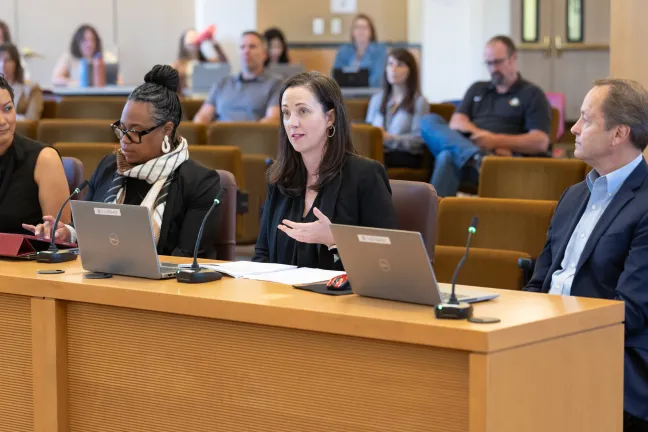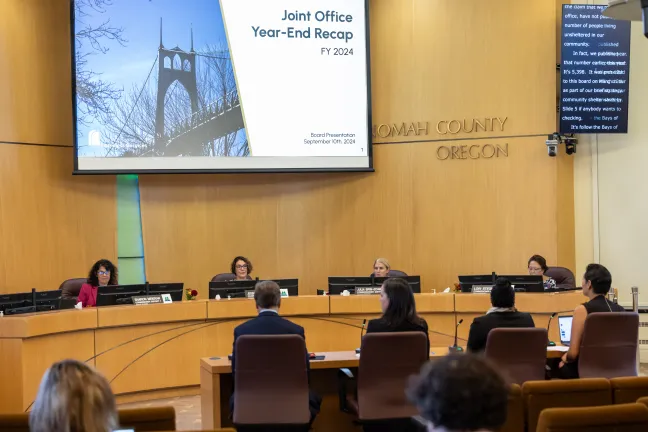Sharing improved outcomes and accelerated investments in services, the Joint Office of Homeless Services on Tuesday, Sept. 10, briefed the Board of County Commissioners on its work serving thousands more people in housing and shelter this past fiscal year.
The department shared that in FY 2023-24, through the work of dozens of providers, it had:
- Supported nearly 5,500 people moving into homes and leaving homelessness — an increase of 28% over the previous year.
- Served 9,101 people in accessing a shelter bed, a 30% increase over the previous year.
- Served people of color, in housing and shelter, at or above goal rates for addressing disparities in homelessness.
- Exceeded its Metro-approved target spend of 75% of its Supportive Housing Services program budget — and spent every dollar collected by Metro this past fiscal year, and whittled down carryover funds left from previous years.
- Made progress in its 10-year goal for creating new supportive housing units, after three years of the Supportive Housing Services measure, and is on track to meet the goal in only five years.
“I’m proud to show the Joint Office showed strong gains in both performance and spending this past fiscal year, and we have made great strides in our urgency and accountability in relation to this work,” said Chair Jessica Vega Pederson. “What this really equates to is better support for people who are connected to our services. These are shelter beds for people. This is the opportunity to stay housed and safe. These are really good outcomes for community members who are part of the priority populations that we're serving. And for many, this is a brand-new life.”
“By no means is this a victory lap. This is important work, and we take it very seriously,” said Joint Office director Dan Field. “We're simply trying to acknowledge the distance we've traveled in building a sustainable homelessness response department, while still acknowledging the very serious work that lies ahead of us.”
Performance on key metrics
The Joint Office shared several of its metrics for tracking performance, while explaining that dashboards tracking additional key performance indicators are just months from launching.
Across the system, 5,477 people who had been experiencing homelessness were placed in housing in FY 2024. That’s a 28% increase over the prior year, when 4,266 people were placed in housing.
For shelter outcomes, the Joint Office shared two separate data points. For all shelters who enter data into the region’s Homeless Management Information System (HMIS) — the vast majority of which are funded by the Joint Office — the total people served was 9,101.
Across all shelters, including ones that don’t enter data regularly into HMIS, the total served was 9,392. This is 125% of the Joint Office’s FY 2024 budget goal of sheltering 7,505 people that year.
Joint Office leadership also highlighted outcomes for people who identify as Black, Indigenous and other People of Color.
“As we all know, people of color are disproportionately represented in the folks experiencing homelessness,” said Anna Plumb, deputy director of the Joint Office. “It is an extreme value and focus of the Joint Office to reduce those disparities to serve people equitably.… One way to do that is to serve people at or above their proportion of the relevant population.”
In FY 2024, 58.3% of people placed in housing identified as BIPOC, a higher percentage than the overall population that identifies as BIPOC. For housing programs like rapid rehousing, people of color who were contacted had a retention rate of 90% one year after no longer receiving their rehousing rent assistance — which was higher than the overall rate of 87%.
The numbers follow a review of Joint Office housing data by the independently elected County Auditor’s Office, which found accurate and “excellent results” after the Joint Office worked proactively to address challenges in data reporting in previous years.
Presenters also highlighted work now under way this fiscal year, including the active launch of a Shelter Availability Tool pilot project, the formation of an Outreach and Engagement Strategy Group, and progress on updating shelter contracts to ensure they are adequately funding needed services.
Additionally, the department will launch new and improved dashboards in the coming months to better communicate about the work it’s doing to reduce homelessness in Multnomah County.
Year-end department finances
Presenters shared an update on the department’s finances. In FY 2023-24, the department spent $290 million, or about 82% of its $353 million total budget. That overall budget was far larger than normal because it includes significant carryover funding from previous fiscal years.
The vast majority of spending — $247 million — was on contractual services, meaning those dollars went directly to the frontline service providers who connect people with housing, shelter and other services.
The department also shared its progress on efficiently and effectively using its resources provided by the voter-approved Supportive Housing Services Measure. Over the previous two years, the Joint Office did not meet its ambitious spend-down goals for the measure. This year, however, the Joint Office spent more than 100% of its share of Supportive Housing Services revenues collected by Metro during Fiscal Year 2024 (not including carryover from previous fiscal years).
The Joint Office spent $143 million in Supportive Housing Services dollars last fiscal year, about 80% of its total Supportive Housing Services program budget — exceeding the 75% spending target the County agreed upon with Metro for the fiscal year.
Joint Office Director Dan Field said that while some people ask why the department didn’t spend every single dollar in its budget on ongoing programs this year, the department has to ensure it can sustain programs year over year once the carryover is spent down, which is expected to happen this fiscal year.
In fact, for FY 2025, presenters said they are facing a $35 million shortfall, because the amount of carryover was less than was forecast during the FY 2025 budget process, in part because of spending accelerating during FY 2024. Additionally, revenues from the Supportive Housing Services Measure will be less than Metro had forecast.
“We made a series of major system enhancements and improvements, all of which come with a significant cost. We made multi-year commitments in several key areas, most notably supportive housing and emergency shelter,” Field said. “We're delivering on the promise of the measure by standing up those programs.… So the good news is, this is exactly what SHS dollars are designed to fund. The difficult news is that it's expensive.”
Field said that Multnomah County would be looking for guidance from the Supportive Housing Services’ Tri-County Planning Body on adjusting the amount of carryover and tapping Metro-required reserve and contingency funding in order to fill the gap.
Commissioner questions and comments
Commissioner Julia Brim-Edwards said she appreciated the improvements in the previous fiscal year, but noted despite that progress, she hasn’t seen a reduction in visible homelessness in Multnomah County, particularly in her east Portland district.
“The same places where we saw lots of unsanctioned camping, and people without shelter, and the impacts on neighborhoods and communities are pretty much the same, especially in my district,” Commissioner Brim-Edwards said. “I’m going to want to see more progress against that. I appreciate that there's been more services provided, more rent assistance, more shelter. And I want to see improvement in the future against the actual numbers, because if we're continually chasing a bigger problem but not making net progress, I think the community is going to call into question whether we're actually successfully making progress.”
Commissioner Sharon Meieran asked about services for people experiencing both homelessness and behavioral health and substance use disorders.
“I think many people who voted for the SHS Measure, myself included, and people doing the work on the frontline, sort of thought that measure was going to account for people who are chronically homeless, living unsheltered, with serious mental illness,” Meieran said. “These are literally the most vulnerable people living unsheltered on our streets who need ongoing wrap-around services that match their needs.… It's like we're avoiding the mental illness and addiction intersection and what the Joint Office is doing about that particular population.”
The Joint Office shared two client stories in their presentation that mentioned people finding housing after living with substance use or behavioral health issues. But Field said he agreed that the Joint Office and other County departments should continue to talk more about recovery resources that are available.
“I'd like to come back with partners from other parts of the County, including behavioral health, and perhaps we could have a discussion around all of the County’s investments that are specifically aimed toward recovery and treatment beds. Because I think what you're proposing is, how do we look holistically at our investments in that subset of resources.”
Commissioner Lori Stegmann asked presenters to further explain the regularly updated HMIS by-name data that the Joint Office currently uses to measure homelessness in the region — replacing the flawed but federally required biennial Point in Time Count as the standard. The new by-name data, released earlier in 2024, provides the most accurate count to date for people experiencing homelessness in Multnomah County: 11,153 people as of January 2024.
“I'm trying to understand what are the barriers or the shortcomings of the by-name list. And is HMIS the appropriate tool for us to truly count every single person who's on this list?” Stegmann asked.
Presenters explained that every time someone accesses services that are logged in HMIS — like staying at a shelter, connecting to a street outreach team, or using certain drop-in services — they are added to the by-name list of people experiencing homelessness.
“I think it's by far the most accurate list that we have; 11,153 people is, I think, a very accurate count,” Plumb said. Plumb said the department relies on snapshots of data, like the ones provided by the by-name list, to illustrate the scope of the homelessness crisis and who is affected by it.
She said data improvement work is continuing — like current work to de-duplicate people who move in and out of Multnomah County and might also be included in Washington and Clackamas counties’ data.
Chair Vega Pederson underscored the progress the department has made over the past year.
“I really want to say how grateful I am to everybody for working hard to achieve those goals, and to really lean into the partnerships, the performance and the transparency that folks have really been asking for,” she said. “We all know that there's a lot more work to do, but I think we're set up really well to do that.”


